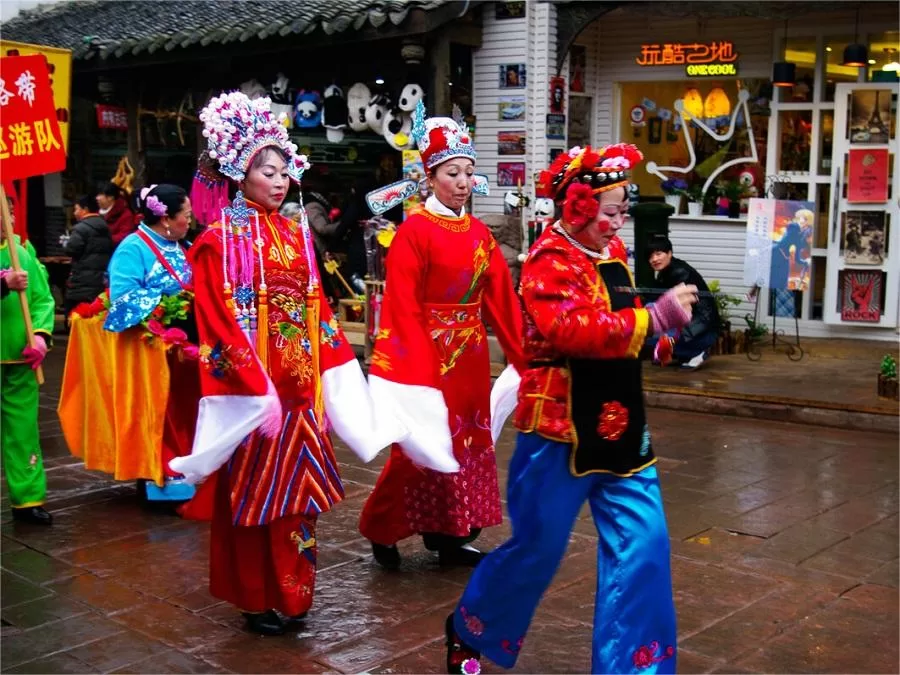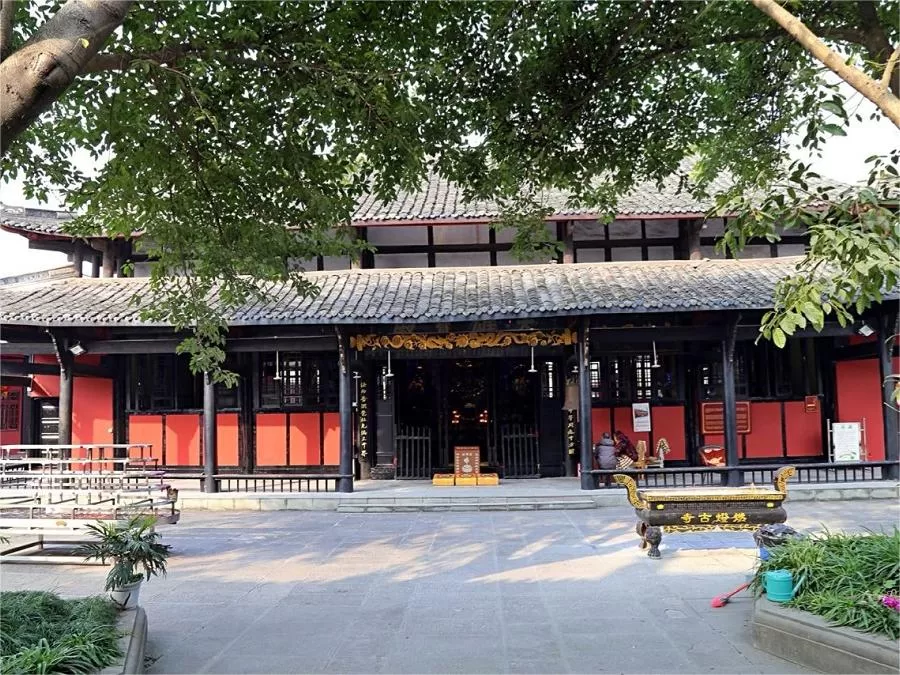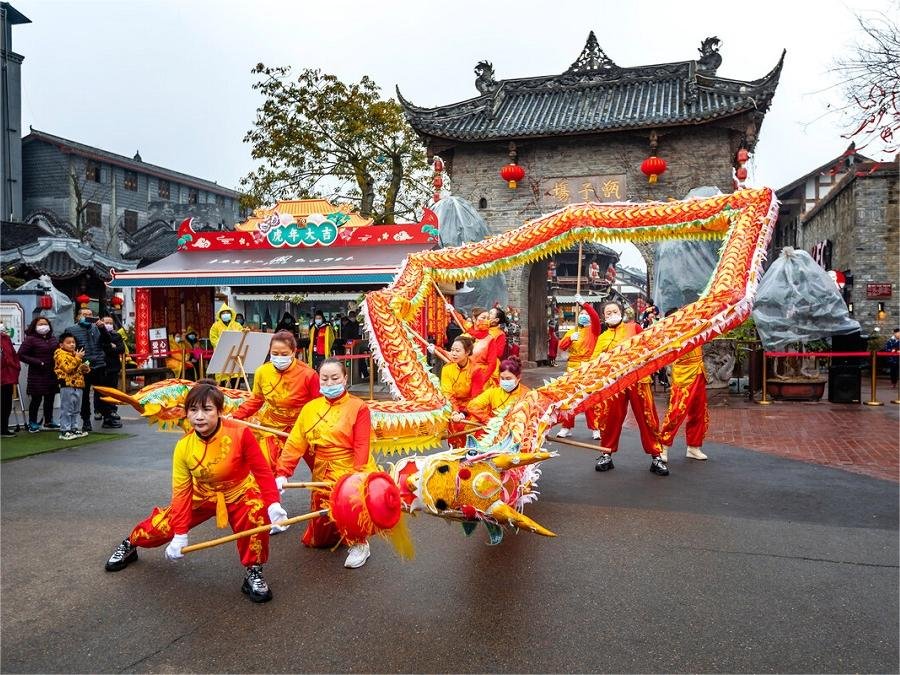Luodai Ancient Town (洛带古镇), located in the Longquanyi District of Chengdu, is approximately 20 kilometers away from the city center. This charming town stands out as one of the well-preserved Hakka ancient towns on the outskirts of Chengdu. A visit to Luodai offers a delightful experience of exploring a millennium-old town, savoring local snacks, enjoying tea in street-side tea houses, playing mahjong, and immersing oneself in the rich Hakka culture. It has become a popular choice for weekend leisure among Chengdu residents.
The name Luodai has two origins: one legend suggests that during the Three Kingdoms period, Liu Shan, the Prince of Shu, accidentally dropped his jade belt into an octagonal well while playing in the town, hence the name “落带” (Luodai, meaning “fallen belt”). Another origin is associated with a river in the area described as “天落之水状如玉带” (a river where the water falls like a jade belt), giving the town its name.
The town boasts well-preserved ancient streets and Hakka-style residences. The layout of the old street follows a pattern of “one main street and seven alleys,” with numerous shops lining both sides of the street. Four major guildhalls (Guangdong Guildhall, Jiangxi Guildhall, Huguang Guildhall, and Chuanbei Guildhall) and the Hakka Museum retain the historical ambiance of the Hakka community.
Due to the concentration of Hakka people, Luodai Ancient Town celebrates various Hakka festivals. The lively Fire Dragon Festival during the Chinese New Year and the Water Dragon Festival in July and August contribute to the vibrant atmosphere of Luodai. These festivals showcase the town’s cultural richness and provide visitors with a unique opportunity to witness and participate in Hakka traditions.
Table of Contents
- Basic Information
- Location and Transportation
- Highlights of Luodai Ancient Town
- Vlog about Luodai Ancient Town
- Useful Tips from Genuine Reviews
- Other Attractions in Suburb of Chengdu
Basic Information
| Estimated Length of Tour | A day |
| Ticket Price | Free |
| Opening Hours | The town is accessible 24 hours a day. But most attractions are only open from 9.00 to 17.00 |
| Telephone Number | 0086-028-84893693 |
Location and Transportation
Luodai Ancient Town is located in the eastern part of Chengdu, the capital city of Sichuan province in southwestern China. It is situated approximately 20 kilometers away from Chengdu’s city center. Nestled in the Longquanyi District, Luodai Ancient Town enjoys a picturesque setting surrounded by lush green mountains and beautiful countryside.
The town is strategically positioned along the ancient Tea Horse Road, which was a vital trade route connecting Sichuan with Tibet and other regions. Its location made it a bustling commercial hub in ancient times, attracting merchants and traders from all over. To get there from Chengdu, you can choose the following ways:
Bus: Take bus 219, 850, 852, 853A, or 884, get off at Luodai Tourist Center, and walk about 50 meters to the south to reach the town.
Express Coach: There are express coaches to Luodai Ancient Town at Xinnanmen Bus Station (新南门车站), which is on metro line 3. They depart about every 15 minutes from 7.45 to 17.10, and the ticket price is 6.5 RMB.
Highlights of Luodai Ancient Town
Hakka Architecture

Luodai Ancient Town is renowned for its exceptional Hakka architecture. The town is dotted with traditional Hakka-style buildings, showcasing the unique design and craftsmanship of the Hakka people. These buildings feature distinctive characteristics such as enclosed courtyards, thick rammed-earth walls, and exquisite woodwork. Intricate carvings, colorful paintings, and ornate roof decorations add to the aesthetic appeal. The architecture reflects the Hakka people’s emphasis on practicality, resilience, and a strong sense of community.
Guangdong Guildhall

The Guangdong Guildhall, situated on the south side of Luodai Old Street, spans an area of 2712 square meters. Originally constructed in 1746 by Hakka people from Guangdong, it was initially named “Nanhua Palace” due to its association with the founder of Zen Buddhism, the Sixth Patriarch Huineng, also known as “Nanhua Dao Ren.” Unfortunately, a fire destroyed major halls,and only the grand gate, opera stage, and side buildings on both sides of the front courtyard remained. Extensively renovated in the ninth year of the Guangxu Emperor’s reign, the guildhall served various purposes over the years. Today, it stands as one of China’s best-preserved and grandest guildhalls, showcasing a distinctive Lingnan architectural style and serving as a landmark in Luodai Ancient Town.
Water Dragon Festival

The Hakka Water Dragon Festival in Luodai Ancient Town is a centuries-old folk tradition. Originating from the Hakka people’s practice of performing water dragon dances to pray for rain and a bountiful harvest during summer, this custom migrated to Luodai with large-scale immigration, evolving into the present-day “Hakka Water Dragon Festival.” Dancers, often shirtless and wearing shorts, skillfully maneuver the dragon as spectators playfully splash water using water guns and basins. The Hakka believe that the more soaked the dragon becomes, the more prosperous their fortunes will be, symbolizing the cultural connection between water and wealth in this lively celebration.
Randeng Temple

Randeng Temple, with roots tracing back to the Sui Dynasty, originally known as “Xinxiang Ci” (信相祠), has a rich history deeply embedded in Chinese Buddhism. During the Tang Dynasty, under the guidance of Master Farun and Master Wudazhigu, the temple gained prominence. In the Song Dynasty, Emperor Zhenzong bestowed the name “Ruiying Chan Yuan” upon the temple. Since the Qing Dynasty, the temple has been known as Randeng Temple due to the enshrinement of a statue of the Lamp-lighting Buddha.
Despite facing challenges during the Cultural Revolution, Randeng Temple was later rejuvenated through the efforts of local Hakka people and compassionate monks. The temple, adorned with numerous historical inscriptions and couplets, houses statues made entirely of pure copper.
Hakka Dragon Dance

Hakka Dragon Dance, a recognized intangible cultural heritage in Sichuan Province, is deeply rooted in Luodai’s tradition of performing water dragon dances to pray for rain. Luodai boasts several professional water dragon teams, including male dragons, female dragons, and baby dragons. The renowned “Liu Family Dragon” represents Luodai’s Hakka Dragon Dance, with participants exclusively from the Liu family, who are Hakka people from Jiangxi. Residing in Luodai for over 300 years, the Liu family has celebrated the festive occasion of dancing dragons for more than three centuries. This internal family tradition has preserved the ancient Chinese dragon dance’s original rituals and ceremonies, providing a glimpse into the dance’s primitive and authentic practices.
Vlog about Luodai Ancient Town
Useful Tips from Genuine Reviews
Rent Ethnic Costumes: Consider renting ethnic costumes to immerse yourself in the experience. “筒子楼” (Tongzilou) and shops on the commercial street offer rentals. Prices vary among stores, so compare options before renting, but generally, the prices are reasonable.
Convenience at the Entrance: Right at the entrance, there are popular cafes like Rui Xing Coffee and Meixue Bingcheng (蜜雪冰城), so there’s no need to carry water from afar. The town offers a variety of affordable snacks. Additionally, numerous handcrafted jewelry stores sell beautiful earrings at around 25 yuan per pair, sometimes with buy-three-get-one-free offers if you’re lucky.
Visiting Jinlong Great Wall: Towards the end of Luodai Ancient Town, if you plan to visit the Jinlong Great Wall (built in 2001), there are usually vehicles offering rides. The cost might range from 5 to 20 yuan per person depending on the number of people. Alternatively, public buses are available. At each of the five watchtowers along the Great Wall, vending machines provide drinks, eliminating the need to carry your own water.
Suggested Sequence of Activities: It’s recommended to visit the Jinlong Great Wall first and then explore the ancient town. This allows for ample time to enjoy both attractions. Climbing the Great Wall can be physically demanding due to some steep paths, despite it being just over 1000 meters long. Once back in the ancient town, there are plenty of shops and activities for eating, drinking, and entertainment.







